A new large Saharan dust cloud is moving across the Atlantic Ocean. It is currently covering a large portion of the tropical Atlantic, heading for the Gulf of Mexico, and will reach the southern United States this weekend.
Strong thunderstorms and convective systems over Africa can create massive dust storms. The pressure patterns and winds in the Atlantic are currently very favorable, carrying these massive dust storms across the ocean toward the United States.

SAHARAN AIR LAYER
These large dust clouds are also called “SAL” (Saharan Air Layer). This is a mass of very dry air, filled with desert dust that forms over the Sahara during late spring, summer, and early autumn.
Some larger dust storm events can also form in early Spring. These dust storms move over the tropical North Atlantic. They can “pulse” every few days, sending new waves of dust. Some events during the warm season can reach very high volumes of dust and can reach far to the west.
The desert regions of northern Africa are estimated to release about 800 million tons of dust each year. That is 70% of the total global dust emissions, and six times more than the next largest source, Asia. A large portion of these emissions is carried to the west over the Atlantic Ocean. Image by Adams et al. 2012.

Near the eastern coast of South America, over 130 million tons of dust particles can still remain in the air, and roughly around 30 million tons fall to the surface over the Amazon basin. This acts as a natural fertilizing process for the Amazon rainforest.
In the image below you can see the monthly dust deposits in Barbados and the southeastern United States, from 2004 to 2009. We can see an obvious annual cycle, peaking during the Summer season in the southeastern United States.

The Saharan Air Layer is warm, stable, and very dry. It has about 50% less moisture than the typical tropical atmosphere. The warmth, dryness, and strong winds associated with these events have been shown to suppress tropical cyclone formation and intensification.
As the dust storm crosses the Atlantic, it usually occupies a 3 to 4km (2 to 2.5-mile) thick layer of the atmosphere with its base starting about 1.5km (1 mile) above the surface.
But how can these large dust storms travel so far to the west and even reach the far northern parts of the United States and Canada? The answer is the tropical Trade Winds.
TROPICAL STEERING SYSTEM
Trade winds are the prevailing easterly winds that circle the Earth near the equator. They are stronger and more consistent over the oceans. These easterly winds at low and higher levels act as a natural steering mechanism for dust storms and also for tropical storms during the hurricane season.
The image below shows the main near-surface wind directions, with global trade winds in yellow and red colors. In the North Atlantic, the circulation pattern is clockwise, as a semi-permanent high-pressure system is present in that region.

The trade winds are not really that strong. Their average speed is 5 to 6 meters per second (11 to 13 miles per hour), reaching up to 13 meters per second (30 miles per hour) or more. But the true power of the trade winds is in their persistence.
In the image below you can see the average surface winds in the past 40 years. This nicely reveals the prevailing easterly trade winds and the high-pressure (clockwise) circulation in the North Atlantic.
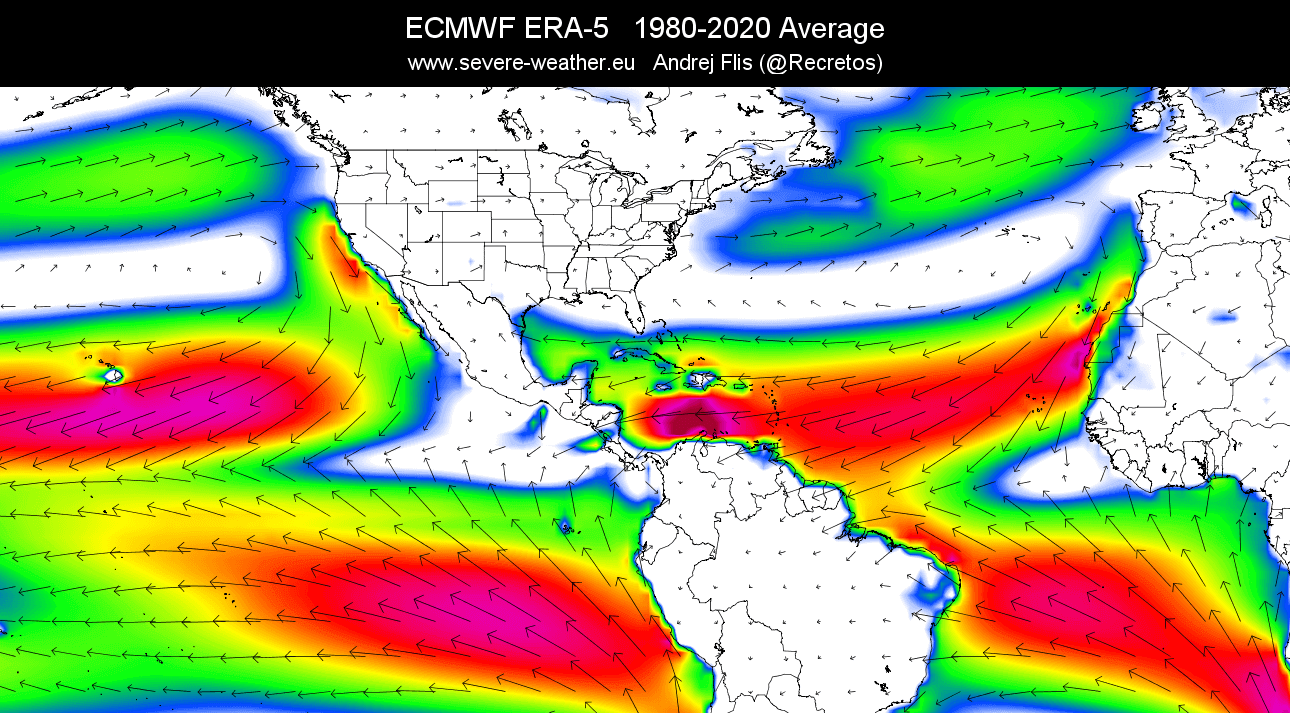
We also produced a 40-year average for sea level pressure in the late winter to spring period. The image below shows the persistent high-pressure system in the subtropical North Atlantic. This explains the direction of the trade winds, as high-pressure systems spin clockwise in the Northern Hemisphere.

SAHARAN DUST STORM SEASON
As mentioned above, the dust storm activity in the Atlantic usually starts in Spring. It is first more contained in the tropical regions but eventually reaches further to the west and southwest.
The satellite imagery below, reveals a strong Saharan dust event emerging into the Atlantic Ocean this March. We can see a large dust cloud moving over Cape Verde. This was the first larger event this season.

The aerosol analysis on March 5th, revealed a large dust cloud moving towards the west-southwest, with high dust loading. Image is by ADAM – Earth explorer platform.

FROM SAHARA TO THE UNITED STATES
Currently, a new larger dust storm event is ongoing. A large cloud is moving over the Atlantic Ocean and is expected to reach the southern United States this weekend.
Real-time satellite imagery for yesterday already revealed a large mass of dust moving from Africa into the Atlantic. The direction shows the dust cloud is being carried by the prevailing easterly trade winds.

We produced a special graphic from the NASA GEOS data, which shows the dust column mass for May 18th. Basically, it reveals the dust loading/concentration in the atmosphere. Higher values mean a stronger dust cloud.
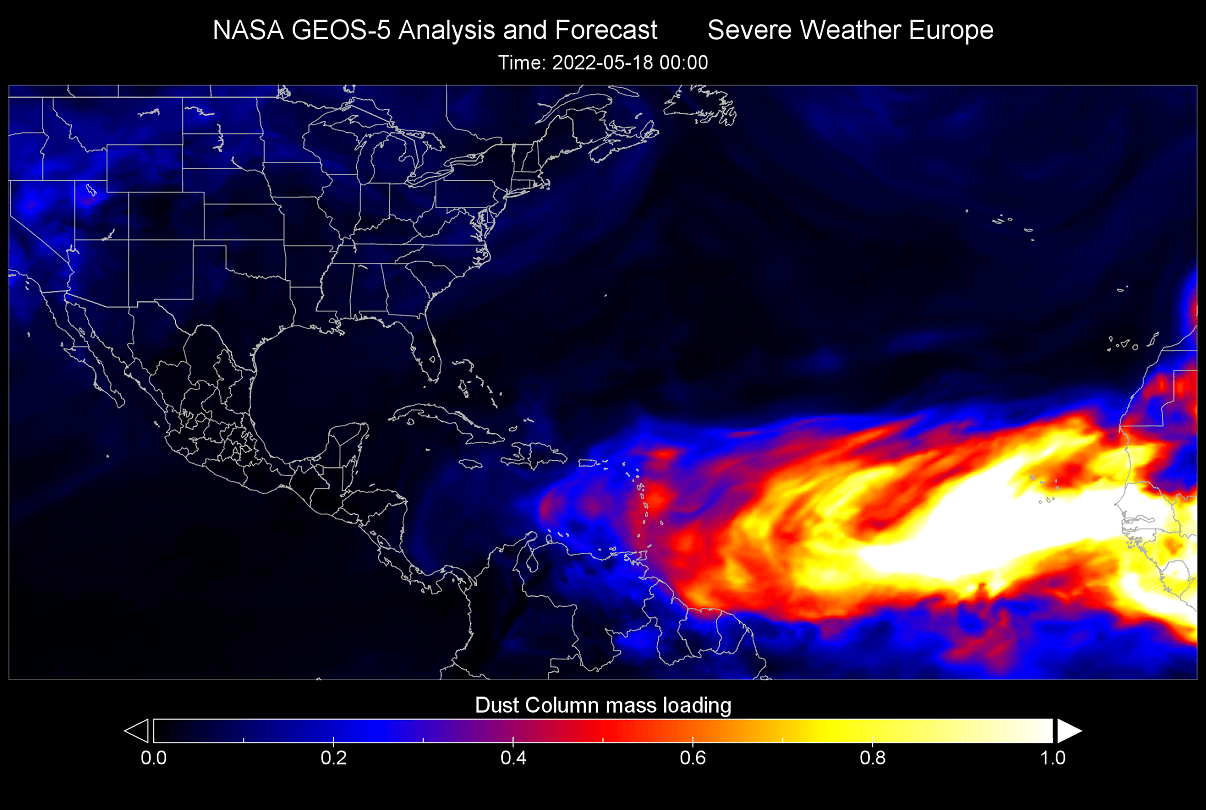
The edge of the dust cloud was already reaching into the Lesser Antilles, with a larger mass following behind.
Yesterday, the far western edge of the dust cloud reached the Caribbean. The easterly trade winds are strong, enabling the dust cloud to cover a large distance in a short time period. This image is from NOAA GOES-East satellite.

Studies have shown, that iron-rich particles inside these dust clouds reflect sunlight and can cool the atmosphere. The fine dust particles also reduce the amount of sunlight reaching the ocean, temporarily reducing the heating of the ocean surface, during the passage of the dust storm.
In the image below, we can see the dry layer reaching from the west coast of Africa into the Caribbean Sea. This is one way of tracking these dust events.
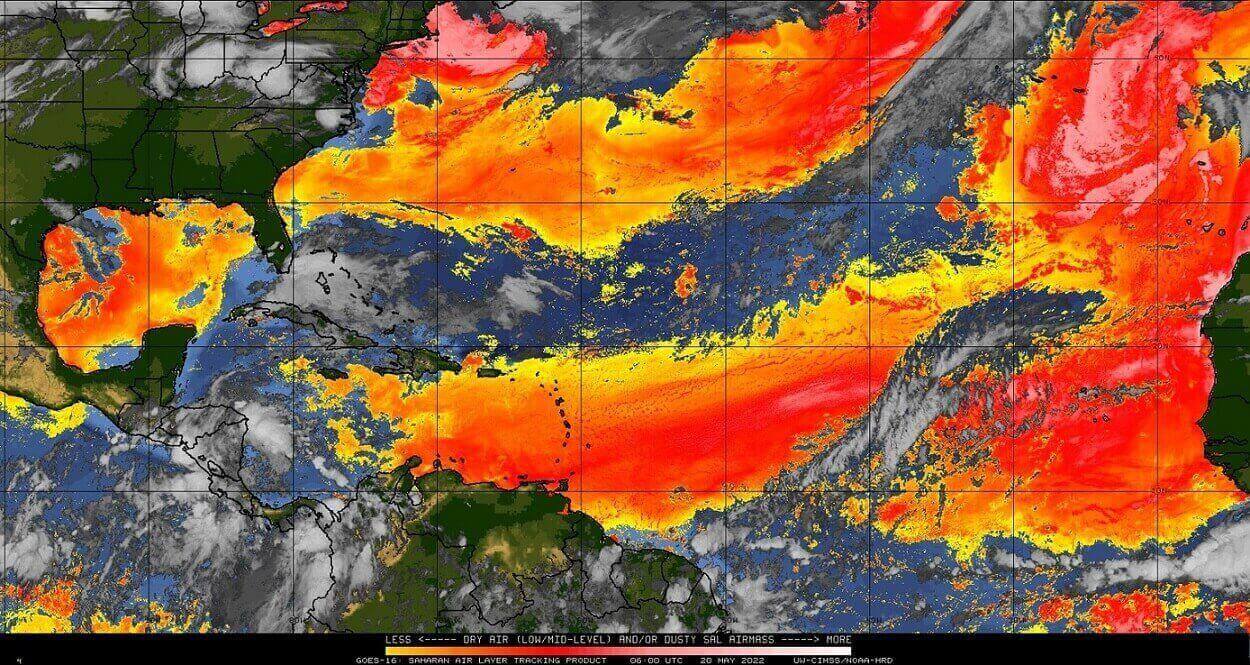
Below we have the NASA dust data for yesterday, which shows the dust column mass. It is in line with the satellite observations, showing the dust storm reaching into the Caribbean sea.
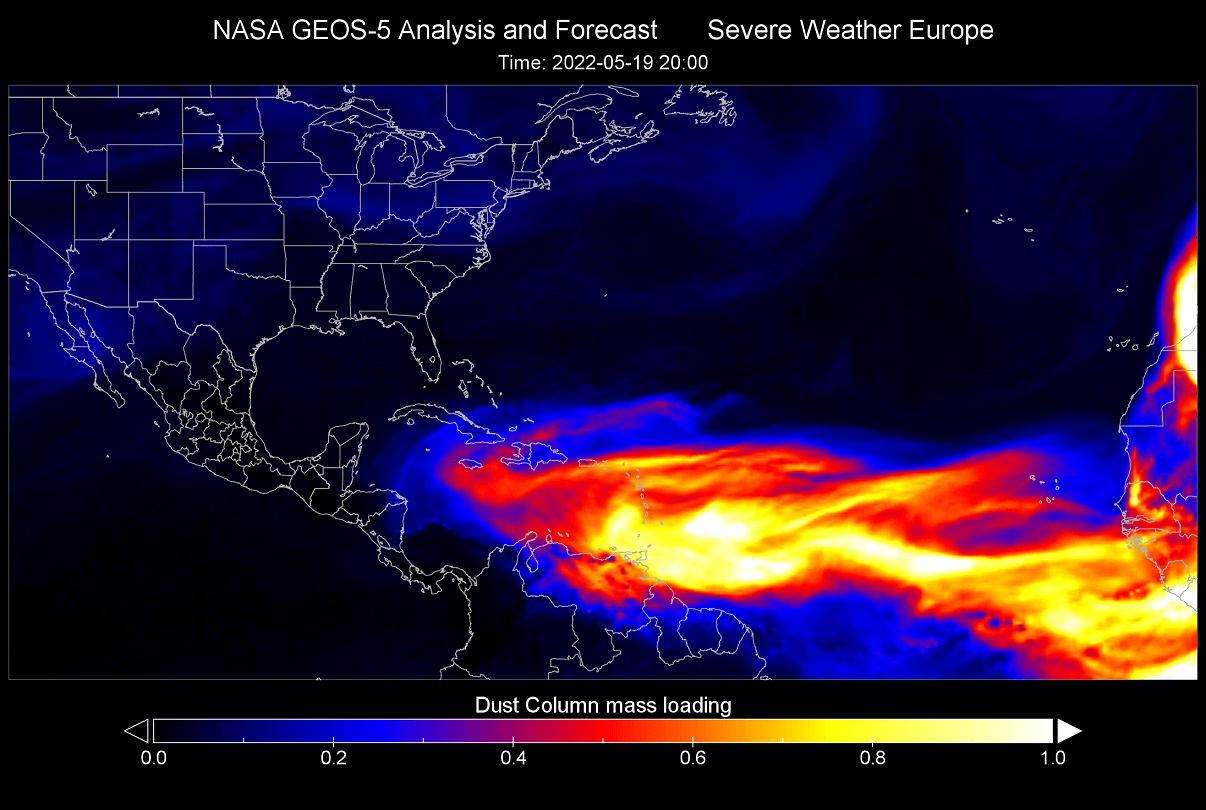
The main plume was reaching more than halfway across the tropical Atlantic, with lower concentrations already reaching into South America.
The latest daytime satellite analysis from yesterday nicely shows the dust plume under a lower sunlight angle. This image is from the NOAA GOES-16 satellite.
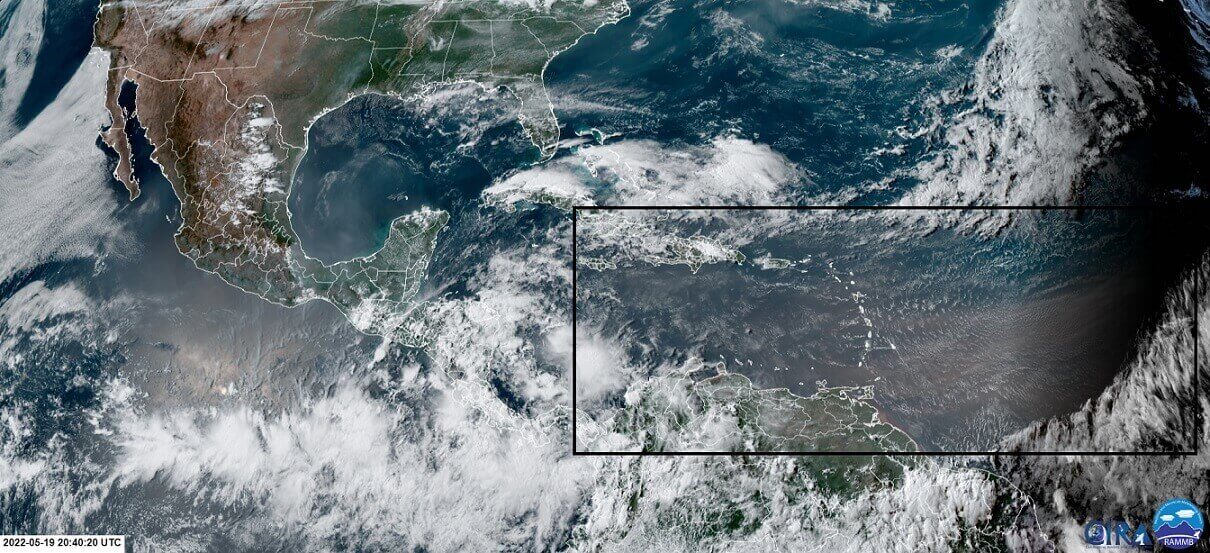
An atmospheric sounding shows the temperature, dew point, and winds with altitude. The sounding below is from the main plume of the dust cloud, and it shows a very dry layer in the lower levels (black box). This is the easiest way to detect the Saharan air layer, as it is warmer and drier in the lower levels.
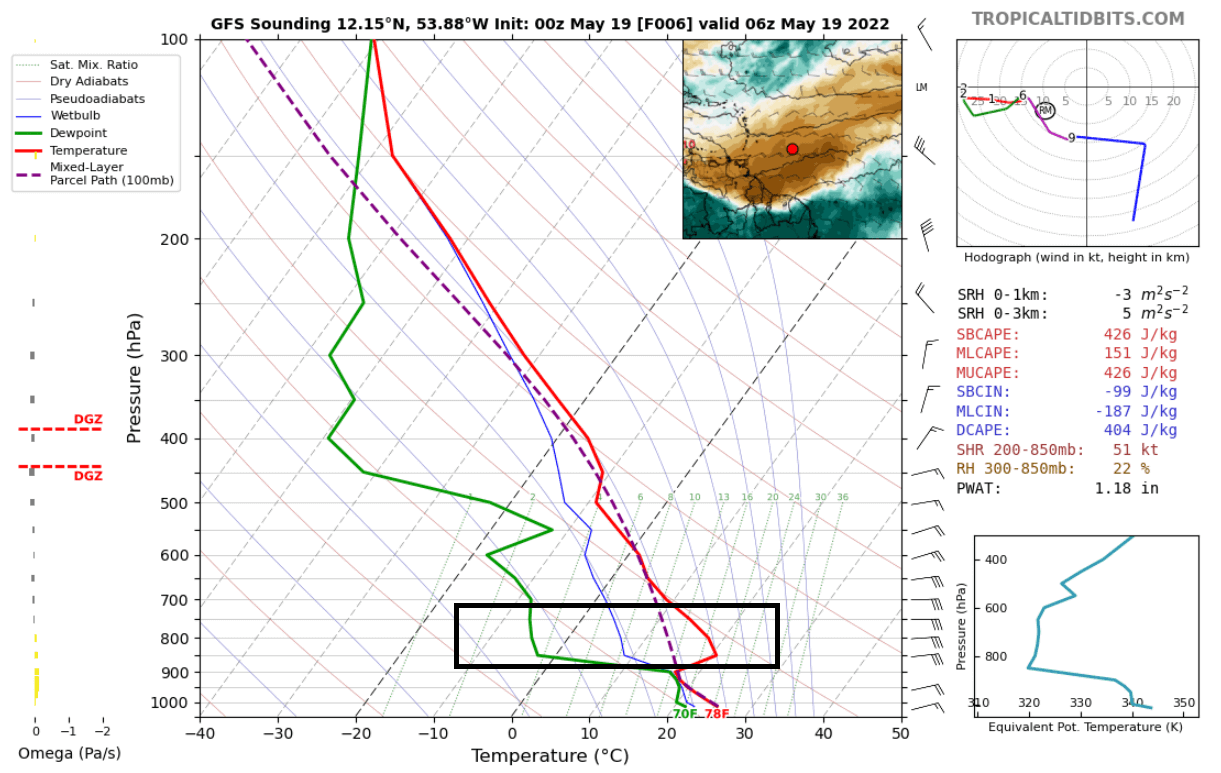
This shows the low altitude of the dust layer, which means that it can drop out of the atmosphere sooner. The higher the dust layer reaches, the longer it can hold its high concentrations before “dissolving”, reaching further west.
We produced a video below, that shows the analysis and forecast of the current dust cloud event. It reveals a strong plume of dust, reaching the southern United States this weekend.
SAHARAN DUST CLOUD FORECAST
The persistent high-pressure system in the central Atlantic is the main steering mechanism for these dust storms. It powers the easterly trade winds that carry the dust clouds from Africa towards the west, sometimes reaching quite a large distance.
Currently, there is a large high-pressure system present in the Atlantic, as seen in the analysis image below. The wind barbs show the wind speed and the main wind direction at the 850mb level (~1.500m/5000ft).

The sea-level pressure anomaly below shows this high-pressure area, marked in red. Currently, there is a strong low-pressure area moving across the United States, which will also help in steering the dust cloud upwards into the United States.

Below we have the dust mass loading from the NASA GEOS-5 modeling system. It simulates the dust cloud reaching the Gulf of Mexico today. The plume is quite long, reaching all the way back to the west coast of Africa.

The Saharan air layer is usually drier than your usual tropical air, so we can track that on the precipitable water in the image below. Drier air, associated with the Saharan air layer is marked in the red box, as it has less moisture and less precipitable water.

The dust forecast from NASA for this weekend, shows higher concentrations reaching deep into the Gulf. We can see the cloud already starting to extend over Florida at this time.
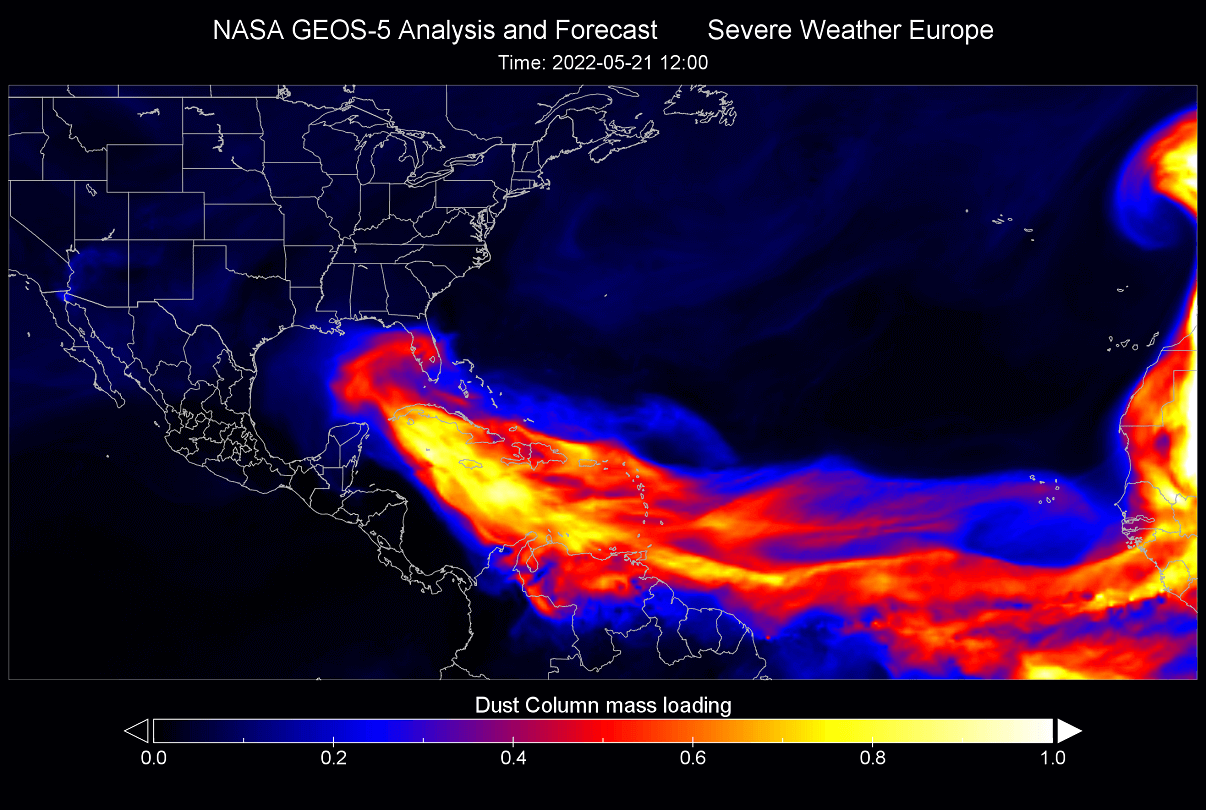
The high-pressure system will remain stable in the North Atlantic, but to the west, closer to the east coast of the United States. That means a more southerly flow coming up from the gulf. This will carry the dust cloud directly into the southern United States.

The sea-level pressure anomaly forecast reveals a strong and stable high-pressure system this weekend, just off the east coast. Air circulates clockwise around a high-pressure system, so the steering flow will carry the dust into the southern United States.
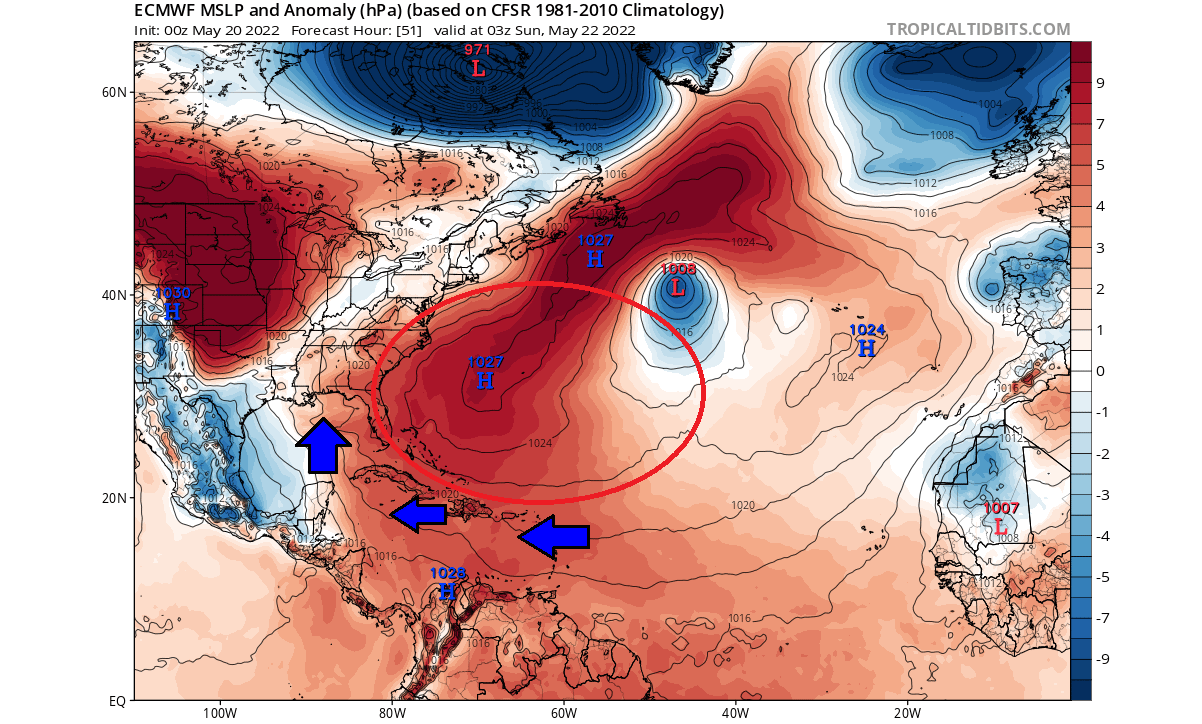
The dust forecast from the NASA GEOS-5 system shows higher concentrations of the dust plume now in the gulf. But by early Sunday, the dust will also reach the southeastern United States.
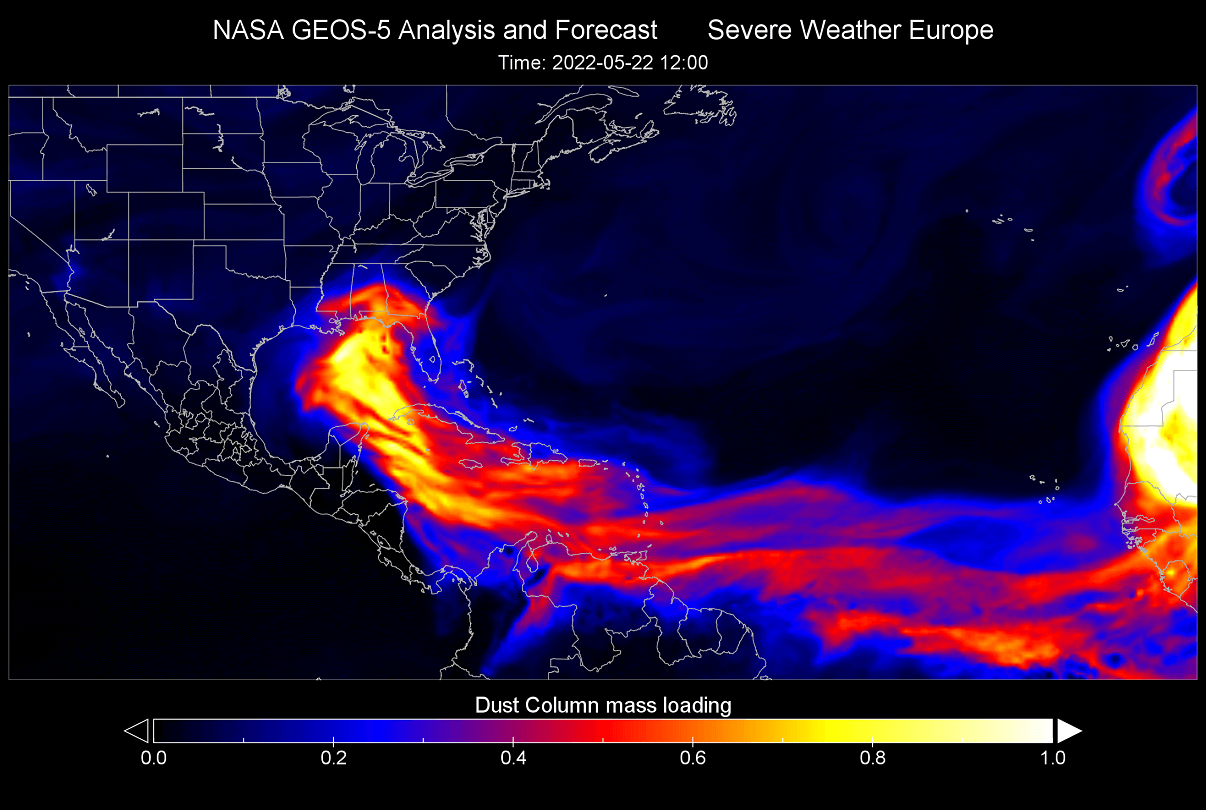
Below is the NASA/GEOS forecast for Monday. It shows the dust cloud stagnating, and spreading over much of the southern coastal region of the United States.
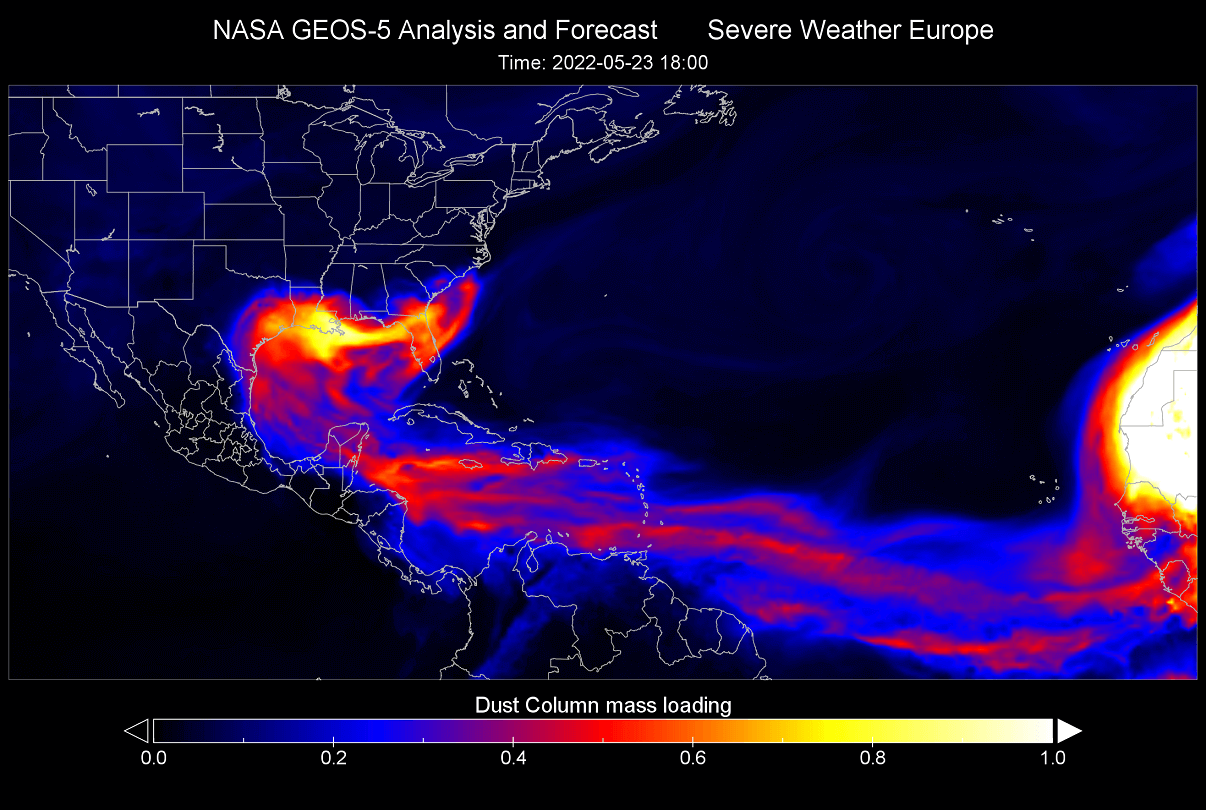
The steering flow will not be strong, as a high-pressure system sits over the northeastern United States. Weak pressure gradients across the western United States will not support a strong southerly flow.
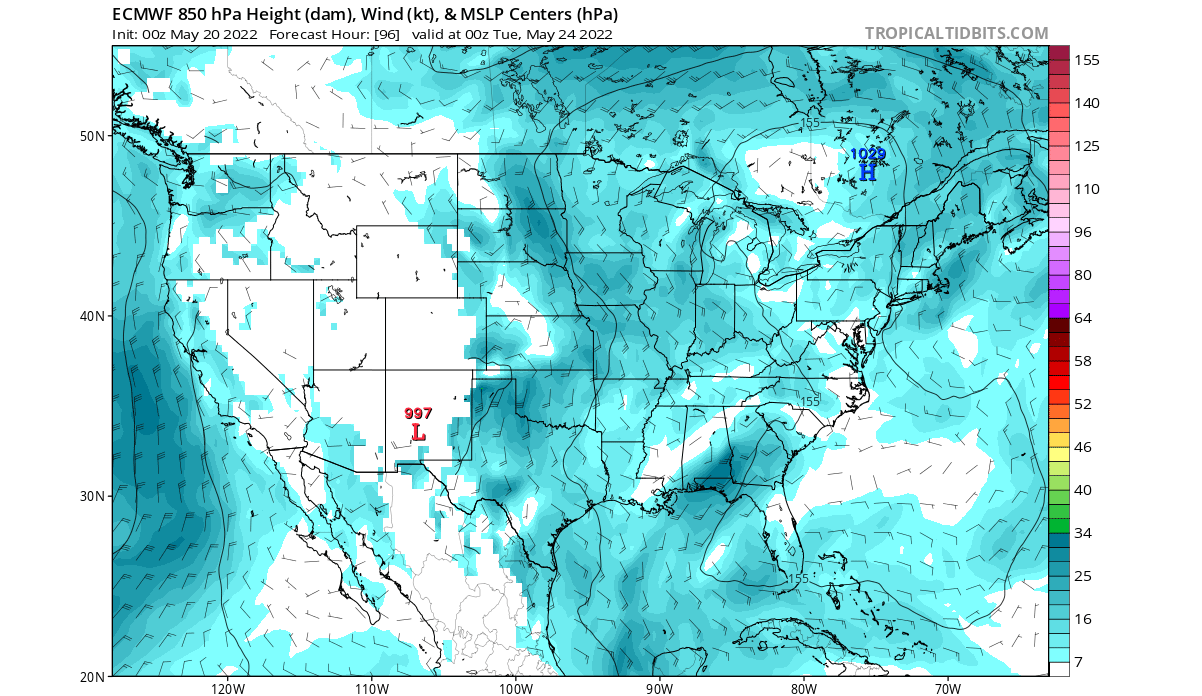
The sea-level pressure anomaly shows a more clear picture, with the high pressure seen over the northeastern United States and eastern Canada. There is some southerly flow over the southern United States but is not configured to reach far to the north.
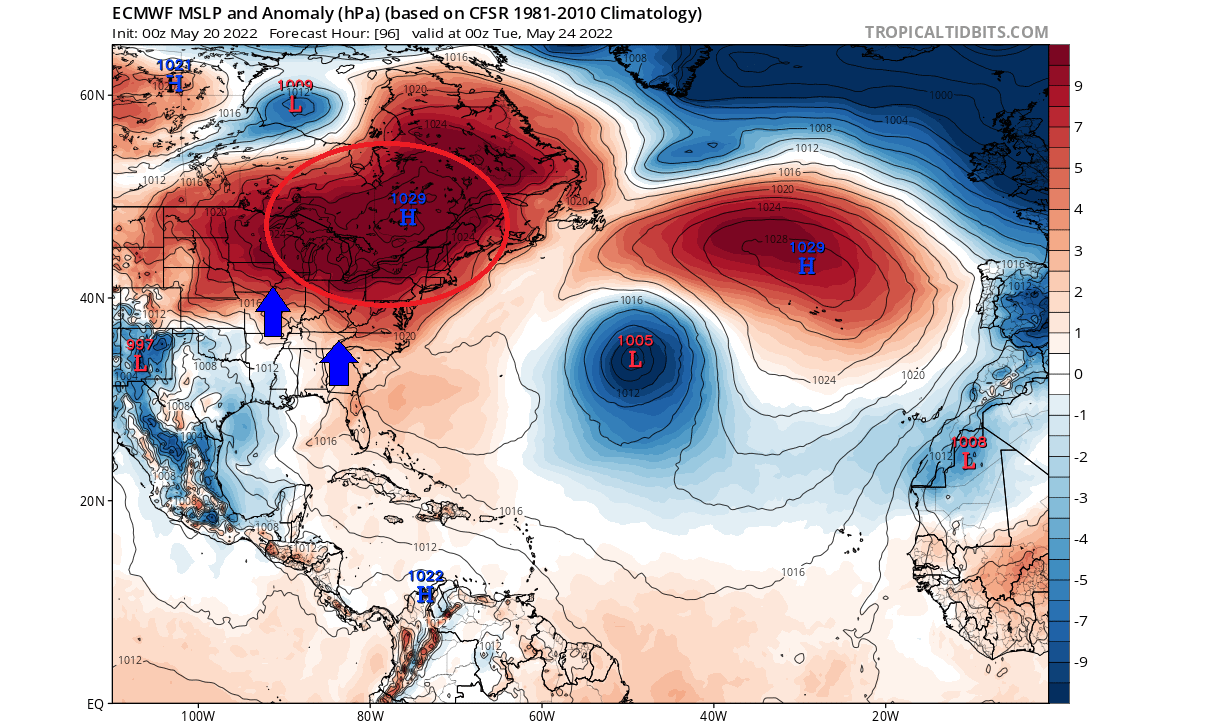
Looking at the dust forecast, we see the dust cloud weakening over the southeastern United States. The dust concentration reduces, as the particles slowly drop out of the atmosphere.

Usually, the peak of the dust storm season is around June and July. So despite not seeing any large events in the near future, we can expect more such events (and larger) in the next few weeks.
LARGE DUST EVENTS
A large dust event in the United States occurred in late June 2020. Below we have 3 images of this strong Saharan Air Layer event. The first image below shows the view of the massive Saharan dust cloud over the Atlantic, as seen from the International Space Station.
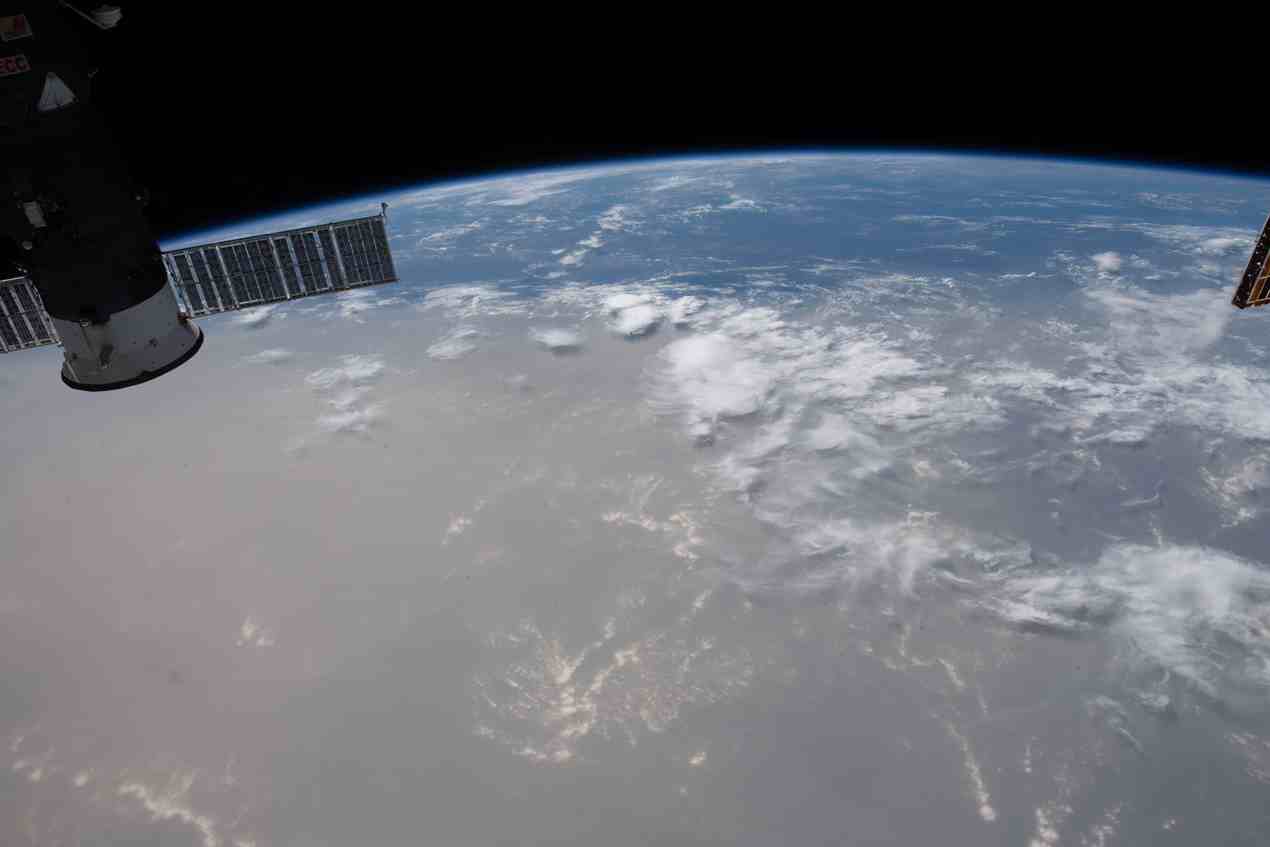
The satellite imagery on June 25, 2020, revealed a dense dust cloud moving into the southern United States from the western Caribbean and into the Gulf of Mexico.

The dust mass/concentration analysis from the NASA GEOS-5 system showed a high dust loading, as the Saharan air layer cloud reached the southeastern United States. The concentrations over the Gulf and gulf coast of the United States were almost twice higher than in the current dust cloud in the Atlantic.

This Saharan Air Layer outbreak was closely monitored using satellites and ground-based stations in the Caribbean. It was quite unusual, as it was about 60-70% dustier than the average Saharan Air Layer outbreak, making it the “dustiest” United States event since records began 15-20 years ago.
DUST CLOUD EFFECTS
Large dust clouds can cause a change in weather, as they typically bring drier and more stable air, which means less precipitation. Fine dust particles can also act as a natural fertilizer, so it is beneficial for the soil.
Saharan dust clouds also suppress tropical activity, which means a reduced risk for tropical storm development and landfall during its activity. Dust particles in the atmosphere also help to create beautiful, vivid sunrises and sunsets, as the dust particles scatter the sunlight.
On the negative side, fine dust particles can significantly reduce air quality, degrade vision, cause eye irritation, and can also cause sinus and respiratory problems. Fine dust particles can cause complications for individuals that already have respiratory problems if the dust is inhaled in higher concentrations.
We will keep you updated on similar nature and weather events around the world, so make sure to bookmark our page. Also, if you have seen this article in the Google App (Discover) feed, click the like (♥) button to see more of our forecasts and our latest articles on weather and nature in general.
SEE ALSO:
*Summer 2022 Forecast Update*: Latest forecast confirms a searing season is ahead